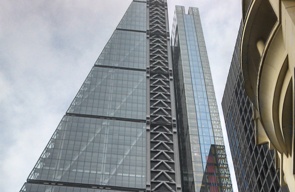Types of building
The word ‘building’ is commonly considered to refer to an enclosed structure within which people can perform activities. See our introductory article: Building.

|

|

|

|

|

|
There are many ways of classifying types of building, including:
- Construction type.
- Cost.
- Use.
- Size.
- Style.
- Period.
- Design (form, structure, etc).
- Performance (energy consumption, accessibility, etc).
- Nature of occupancy/ownership.
This article presents a list of common types of building alphabetically with links to articles providing further information. To add to the list, click ‘Edit this article’ above.
- A frame house.
- Abbey.
- Accessory structure.
- Air-supported structure.
- Affordable housing.
- Airport.
- Apartment.
- Assembly and recreation building.
- Assembly building.
- Bandstand.
- Bank.
- Barn.
- Bungalow.
- Bus shelter.
- Bus station.
- Cafe.
- Canteen.
- Casino.
- Castle.
- Cathedral.
- Cave.
- Chapel.
- Church.
- Cinema.
- Cluster accommodation.
- Commercial building.
- Commonhold.
- Complex buildings.
- Condominium.
- Conservatory.
- Cottage.
- Convenience store.
- Council housing.
- Covered area.
- Custom build home.
- Data centre.
- Department store.
- Detached.
- Double fronted building.
- Duplex.
- Dwelling.
- Earth building (see also Earthen construction).
- Entertainment building.
- Extension.
- Fabric structure.
- Factory.
- Farm buildings.
- Ferry terminal.
- Fire engineered buildings.
- Fire station.
- Flat.
- Freehold.
- Gallery.
- Garage.
- Geodesic dome.
- Greenhouse.
- Groundscraper.
- High-rise building.
- Hospital.
- Hostel.
- Hotel.
- Household.
- Houses in multiple occupation.
- Housing association.
- Hut.
- Industrial building.
- Inflatable building.
- Institution.
- Intermediate housing.
- Kiosk
- Kit house.
- Large format retail premises.
- Lean to.
- Leasehold.
- Leisure centre.
- Library.
- Lighthouse.
- Live/work unit.
- Low-rise.
- Mall.
- Manse.
- Maisonette.
- Meanwhile use.
- Medium-rise.
- Megastructure.
- Megatall.
- Minor development.
- Mixed use development.
- Modern building.
- Modular building.
- Mosque.
- Multi-storey building.
- Museum.
- Non-residential institution.
- Office.
- Outbuilding.
- Pavilion
- Penthouse.
- Permanent building.
- Petrol station.
- Police station.
- Portable building.
- Portaloo.
- Portakabin®.
- Post office.
- Power station.
- Pub.
- Pumping station.
- Prefab bungalow.
- Public building.
- Railway station.
- Refinery.
- Residential building.
- Residential institution.
- Retail building.
- Retail warehousing.
- School.
- Secure residential institution.
- Self build home.
- Semi-detached / Semi.
- Shack.
- Shed.
- Shelter.
- Sheltered housing.
- Shop.
- Shopping centre.
- Single-storey building.
- Simple premises.
- Skyscraper.
- Smoking shelters.
- Social housing.
- Specialist accommodation for older people.
- Specialist premises.
- Speculative development.
- Stable
- Stadium.
- Stand-alone building.
- Star building.
- Stately home.
- Storage building.
- Student accommodation.
- Sui generis.
- Supermarket.
- Super-slender.
- Supertall.
- Supported housing.
- Surgery.
- Swimming pool.
- Synagogue
- Telephone Box
- Temporary building.
- Temporary demountable structure.
- Terminal / terminus.
- Terraced house.
- Theatre.
- Toilet.
- Tower.
- Town hall.
- Traditional building.
- Train station.
- Twisting building.
- Venue.
- Visitor Centre
- Warehouse.
- Windmill.
- Workplace.
- Yurt
- Zero carbon building.
- Ziggurat.
See also: Architectural styles and Use class.
[edit] Related articles on Designing Buildings
Featured articles and news
Homes England creates largest housing-led site in the North
Successful, 34 hectare land acquisition with the residential allocation now completed.
Scottish apprenticeship training proposals
General support although better accountability and transparency is sought.
The history of building regulations
A story of belated action in response to crisis.
Moisture, fire safety and emerging trends in living walls
How wet is your wall?
Current policy explained and newly published consultation by the UK and Welsh Governments.
British architecture 1919–39. Book review.
Conservation of listed prefabs in Moseley.
Energy industry calls for urgent reform.
Heritage staff wellbeing at work survey.
A five minute introduction.
50th Golden anniversary ECA Edmundson apprentice award
Showcasing the very best electrotechnical and engineering services for half a century.
Welsh government consults on HRBs and reg changes
Seeking feedback on a new regulatory regime and a broad range of issues.
CIOB Client Guide (2nd edition) March 2025
Free download covering statutory dutyholder roles under the Building Safety Act and much more.
Minister quizzed, as responsibility transfers to MHCLG and BSR publishes new building control guidance.
UK environmental regulations reform 2025
Amid wider new approaches to ensure regulators and regulation support growth.
BSRIA Statutory Compliance Inspection Checklist
BG80/2025 now significantly updated to include requirements related to important changes in legislation.























Comments
[edit] To make a comment about this article, or to suggest changes, click 'Add a comment' above. Separate your comments from any existing comments by inserting a horizontal line.